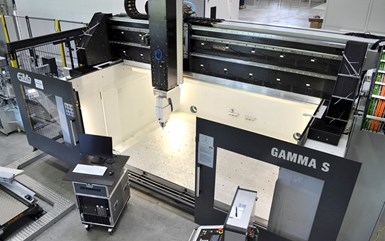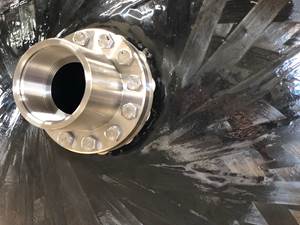Artificial intelligence optimizes CNC milling of carbon fiber-reinforced composites
The Augsburg AI Production Network — DLR Center for Lightweight Production Technology (ZLP), Fraunhofer IGCV and University of Augsburg — use ultrasonic sensors to correlate sound to quality in composites machining.
Ultrasonic sensor mounted on a CNC milling machine for monitoring machining quality. Photo Credit: Copyright University of Augsburg
The Augsburg AI (artificial intelligence) Production Network — founded in January 2021 and based in Augsburg, Germany — brings together the University of Augsburg, the Fraunhofer Institute for Foundry, Composites and Processing Technology (Fraunhofer IGCV) and the Center for Lightweight Production Technology of the German Aerospace Center (DLR ZLP). The aim is joint research into AI-based production technologies at the interface between materials, manufacturing technologies and data-based modeling. One application example where AI can support production processes is the machining of fiber-reinforced composite materials.
In the newly established AI Production Network, scientists are researching how AI can optimize production processes. For example, at the end of many value chains in aerospace or mechanical engineering, CNC machines process the final contour of components made from fiber-reinforced polymer composites. This machining process places high demands on the milling tool. Researchers at the University of Augsburg believe there is potential to optimize machining processes by using sensors that monitor the CNC milling system. They are currently using AI to evaluate the data streams provided by these sensors.
Industrial manufacturing processes are often highly complex, with many factors influencing the result. For example, equipment and machining tools wear out quickly, especially with hard materials such as carbon fiber. The ability to recognize and predict critical degrees of wear is therefore essential to deliver high-quality trimmed and machined composite structures. Research on an industrial CNC milling machine shows how suitable sensor technology, coupled with AI, can deliver such forecasts and improvements.
Structure-borne sound and machine learning

Industrial CNC milling machine used for ultrasound sensor research. Photo Credit: Copyright University of Augsburg
Most modern CNC milling machines have some basic sensors already built-in, which record energy consumption, feed force and torque, for example. However, this data is not always sufficient for the resolution of fine details in the milling process. For this reason, ultrasonic sensors for analyzing structure-borne sound were developed at the University of Augsburg and integrated into an industrial CNC milling machine. These sensors detect structure-borne sound signals in the ultrasonic range that are generated during the milling process and then propagate through the system to the sensor.
The structure-borne sound allows conclusions to be drawn about the state of the machining process. “This is an indicator that is as meaningful to us as bow strokes are for a violin,” explains Prof. Dr. Markus Sause, director of the AI ​​Production Network. “Music professionals can tell immediately from a violin’s sound whether it is in tune and how well the person playing it has mastered the instrument.” But how does this approach work for a CNC machine? Machine learning is the key.
In order to optimize the CNC milling process based on recorded data from the ultrasonic sensors, researchers working with Sause make use of what is known as machine learning. Certain characteristics of the acoustic signal can indicate an unfavorable process control, which points to poor quality of the milled component. As a result, the milling process can be directly adjusted and improved with this information. For this purpose, an algorithm is trained with recorded data and the corresponding states (e. g. good or bad machining). The person who operates the milling machine can then react to the system status information that is presented or the system can be programmed to react automatically.
Predictive maintenance - acting with foresight
Machine learning can not only optimize the milling process directly on the workpiece, but can also plan the maintenance cycles of a production plant as economically as possible. Functional parts need to work in the machine for as long as possible in order to increase economic efficiency, but spontaneous failures due to damaged parts must be avoided.
Predictive maintenance is an approach in which the AI, using the collected sensor data, calculates when a part should be replaced. In the case of the CNC milling machine under investigation, an algorithm recognizes when certain characteristics of the sound signal change. In this way, it not only identifies the degree of wear on the machining tool, but also predicts the right time to replace the tool. This and other AI processes are being incorporated into the AI ​​Production Network in Augsburg. The three main partner organizations are working with other production facilities to create a manufacturing network that can be reconfigured in a modular and material-optimized manner.
Related Content
Otto Aviation launches Phantom 3500 business jet with all-composite airframe from Leonardo
Promising 60% less fuel burn and 90% less emissions using SAF, the super-laminar flow design with windowless fuselage will be built using RTM in Florida facility with certification slated for 2030.
Read MoreInfinite Composites: Type V tanks for space, hydrogen, automotive and more
After a decade of proving its linerless, weight-saving composite tanks with NASA and more than 30 aerospace companies, this CryoSphere pioneer is scaling for growth in commercial space and sustainable transportation on Earth.
Read MoreCutting 100 pounds, certification time for the X-59 nose cone
Swift Engineering used HyperX software to remove 100 pounds from 38-foot graphite/epoxy cored nose cone for X-59 supersonic aircraft.
Read MorePlant tour: Airbus, Illescas, Spain
Airbus’ Illescas facility, featuring highly automated composites processes for the A350 lower wing cover and one-piece Section 19 fuselage barrels, works toward production ramp-ups and next-generation aircraft.
Read MoreRead Next
Next-gen fan blades: Hybrid twin RTM, printed sensors, laser shock disassembly
MORPHO project demonstrates blade with 20% faster RTM cure cycle, uses AI-based monitoring for improved maintenance/life cycle management and proves laser shock disassembly for recycling.
Read MoreCeramic matrix composites: Faster, cheaper, higher temperature
New players proliferate, increasing CMC materials and manufacturing capacity, novel processes and automation to meet demand for higher part volumes and performance.
Read MoreUltrasonic welding for in-space manufacturing of CFRTP
Agile Ultrasonics and NASA trial robotic-compatible carbon fiber-reinforced thermoplastic ultrasonic welding technology for space structures.
Read More












